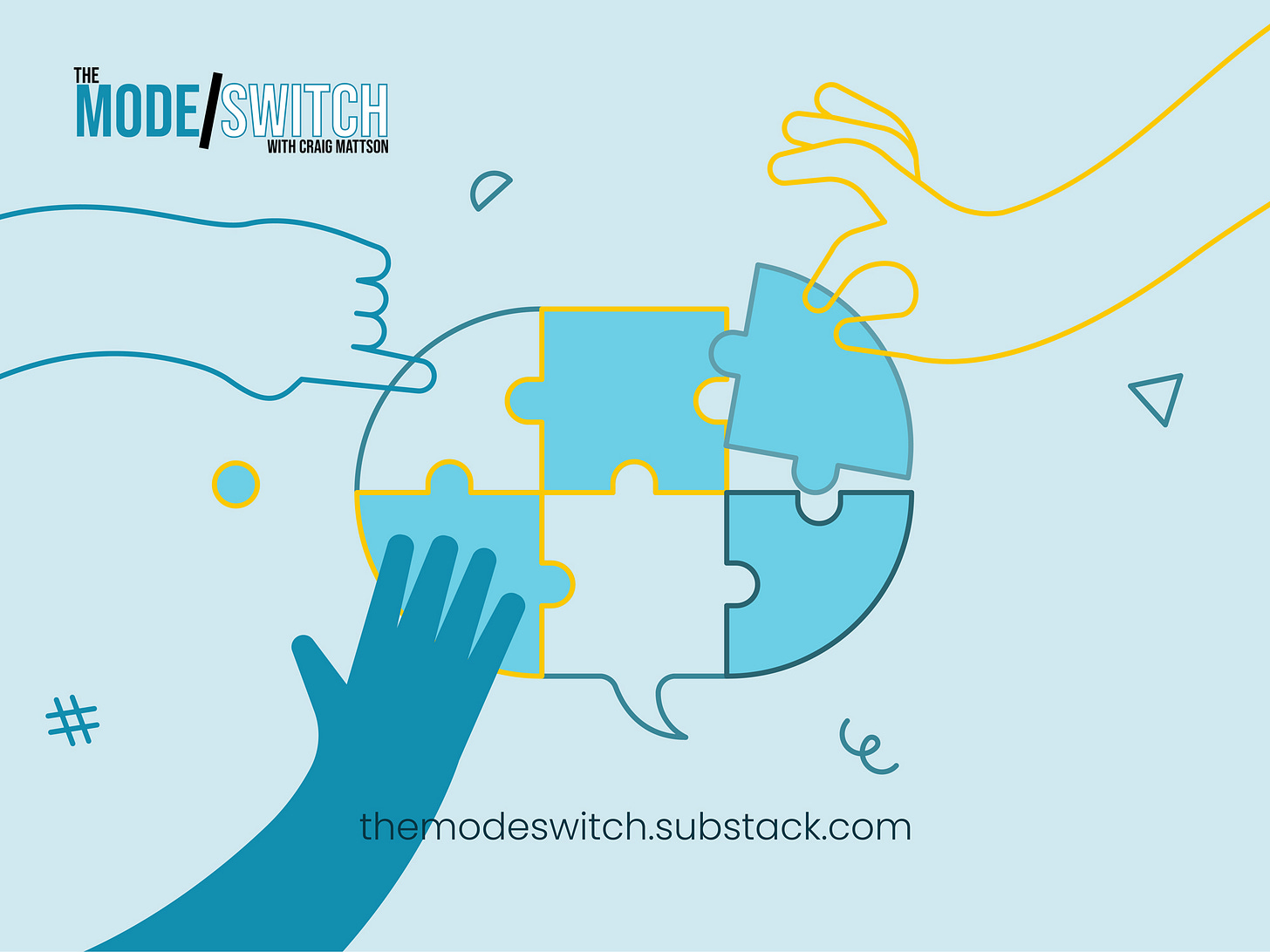Communication You Hope Is Helping... But Isn't
If your emails are littered with exclamation points, this one’s for you
Happy mid-week, Mode-Switchers! We’ve seen a huge jump in subscription this week—so welcome aboard. Here’s a quick, 15-minute podcast (directly above this note) in which LaShone Manuel, Emily Bosscher, and I talk about when playing a role makes you fake at work—and when it makes you exactly what your coworkers need.
Miscommunication between managers and employees is not an unusual event. It is a norm. But all too often perfect connection and flawless comprehension are our ideals for workplace communication. We need a mode/switch.
I just opened Unsplash and search-termed “Conversation with a Manager.” Here are four pics that showed up. Take a close look at what they say about how we imagine professional interaction.
These images tell us something about our ideals for workplace interaction, which apparently should be the following:
One-on-one. The communication theory term for this is dyadic, meaning a pair (in this case a pair of talkers). It’s A and B talking, not A and B and Q and V and K and M aswirl in an alphabet soup. Think of your best conversation ever at work. You’ll almost certainly picture a two-some.
Back-n-forth. These images also depict people caught in moments of give and take, also known as reciprocity. First one person speaks, then the next responds, then the first person talks again—I don’t need to spell this out. It’s the cadence of every ideal script at work.
Heart-to-heart. These professional conversations represent workplace interaction as a disclosure of the self to the other. You speak your heart; I speak mine, and in that sharing mutuality happens.
Put all that together, and you have a vision for elegantly conducted dialogue, in which each employee speaks politely in turn, each manager gets heard, each coworker gets recognized, and each soul indwells another.
But can we all stop for a minute and admit that workplace conversations almost never work this way?
Here’s a story from my research that I used to think was unusual. I’ve come to think it offers important depictions of communication at work.
Cecilia works as a special education classroom assistant in the Chicago Public School system. She’s a wiry, quick-thinking, and good-humored in the classroom. And she has to be. One day, one of her students pulled himself up on a table and started doing a little dance. Sometimes when things would get too complicated in the classroom, Cecilia felt the need to let her supervisor know what was going on. But, on one occasion, when Cecilia reported a problem, the supervisor told her to grow a pair.
I hope your breakdowns with your clients don’t start with a dance and end with an slur. But I also hope you recognize that what Cecilia experienced takes place, in some form or another, in your workplace, too. Based on her story, we might even improvise four categories of communication that aren’t conversational:
Do those scenarios remind you, at all, of the ways that communication functions at work? Do they help you remember how professional interaction may be less about dialoguing and more about dancing, stitching, wrestling, and improvising?
We might wish for warmhearted dialogue. Our yearning shows up in phrases like, “Nobody talks any more” or “C’mon! Get off your phone and have a conversation.” We might even achieve warmhearted dialogue now and then. Give thanks when we do.
But if that’s our only ideal, if that’s all we’re looking for, and if chasing that ideal turns every other communication into an epic fail, then we’re missing out what’s actually, hilariously, and gorgeously happening when we talk with other humans at work.
What else is happening? For starters, performance. Performativity is often a word for fakery, something like green-washing or virtue signaling. But it can also mean communication that takes action. Performativity, in other words, doesn’t send or transmit meanings. It acts. It does stuff. You can call it signaling or code-switching or masking. You can call it bullshit. But I think we should also admit that performative communication is a positive force in workplace interaction.
If all the world’s a stage, then performance is not an unfortunate feature of human life. It is human life. We are all doing cameos in a story that’s still being written. The trick is to act your part in a way that allows other people to act theirs—without insisting that those people and you are joined heart to heart, soul to soul. Some days and in some projects, the improv fails. But other days, the collaborative theatrics produce something none of us could have crafted on our own.
So, here’s the mode switch for this week: Stop treating heart-to-heart conversation like it’s the only kind of talk we should be doing with our managers and our employees. Start recognizing the wide diversity of modes we perform alongside each other and for each other’s good.
But what’s the practical advice this suggests? I have some starters for you to consider.
Stop nodding your head so much. I confess I do this frantic nodding thing all the time, especially in remote meetings, where I bob my head like a puppet of hyper-agreeability. The nodding’s meant to say that I totally understand. I don’t. So, ration your nonverbals. Hold the nod until you sense the miracle of actual agreement.
Don’t resonate so much. Here are a few regularly uttered phrases we should consider using far less often than we do: “I totally agree with everything she just said” and “I just want to piggyback on what he said” and “I’m glad we’re all on the same page.”
Retire the exclamation marks. Emails are strange enough already with all their quirky little phrases like “I hope this finds you well” and “Thoughts?” and “Thanks so much.” But we just make them stranger by infusing them with enthusiastic punctuation. If you’re a nice person, people will figure that soon enough, and through more reliable signals than your exclamation marks.
Offer a response later. Sometimes, it feels like we have to have a punchy rejoinder for whatever people say. But mostly, we don’t. It’s perfectly copacetic to say, “Let me think about that and get back with you.” Waiting to respond till later signals to your manager or your coworker that things might be more complex than they look.
The mode/switch I’m recommending this week is to stop thinking of the heart-to-heart conversation as the paradigm for workplace communication. John Durham Peters (my muse for this issue and for much of my teaching, coaching, and writing for the past twenty years) has said that “dialogue may simply be two people taking turns broadcasting at each other.” Peters admits that’s overstated. But can we concede that funny, awkward, risky, staticky broadcasts are normal at work? Getting better at those should be our goal.
-craig







This reminds me of Mae Martin's bit about human interactions and mental "snow globes" : https://www.youtube.com/watch?v=jE77WFTc8PI